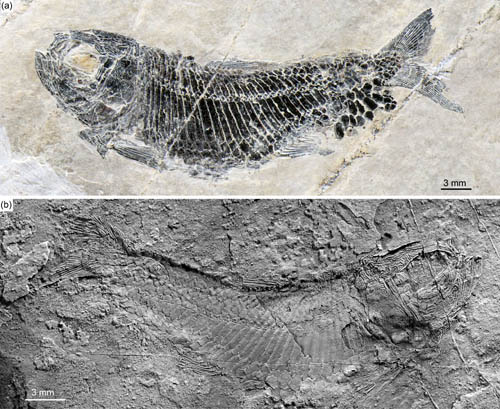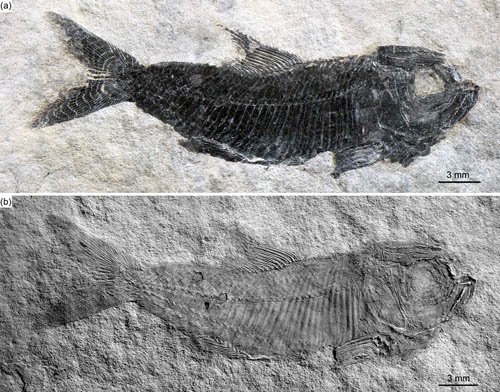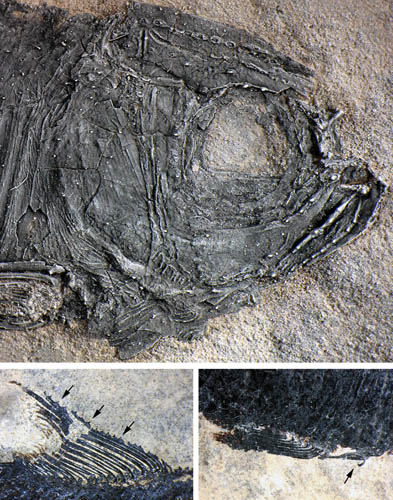Neopterygian Fish with Secondary Sexual Characteristics Found from the Middle Triassic of China
Secondary sexual characteristics are features that appear at sexual maturity and distinguish the two sexes of a species. Studies of secondary sexual characteristics in a species are vital for fully understanding its behavior, reproduction, and evolution. Secondary sexual characteristics are easily observed and studied in living animals, but the situation is rather more complicated in extinct animals, primarily due to inadequacies of sample size or the fragmentary nature of fossil remains.
Neopterygii are the most diverse group of extant ray-finned fishes, which underwent a rapid radiation in the aftermath of end-Permian mass extinction. In a paper published online 23 January in the journal of Science Bulletin, Dr. XU Guanghui, Institute of Vertebrate Paleontology and Paleoanthropology (IVPP), Chinese Academy of Sciences, and his collaborator reported a new sexually dimorphic primitive neopterygian fish, Venusichthys comptus, based on 30 exceptionally well-preserved specimens from the Middle Triassic (Pelsonian, Anisian) Luoping Lagerst?tte of eastern Yunnan, China. The discovery represents the oldest known secondary sexual characteristics in Neopterygii, and provides an important addition for understanding the behavior, reproduction, and early diversification of Neopterygii.
The Luoping Lagerst?tte fossil beds are composed of thinly laminated micritic limestone alternating with silty limestone, indicating a semi-enclosed intraplatform depositional environment. This new species has a blunt snout, an elongate and fusiform body, and an almost homocercal caudal fin with a forked profile. All 30 specimens represent a small-sized primitive neopterygian with a standard length ranging from 25 to 38 mm.
The genus name is derived from the Latin venus, meaning goddess of love, and ichthys, meaning fish. The species name comes from Latin comptus, meaning ornamental. Venusichthys comptus shows a unique character combination distinguished from any other neopterygian families and represents a new family.
“The superb preservation of skeletal details demonstrates a differentiation of phenotypic traits between presumed males and females”, said lead author XU Guanghui of the IVPP, “Among 30 cataloged specimens, one-third of the individuals bear pointed tubercles on cranial bones, scales and fins, and a hook-like contact organ anterior to the anal fin and are interpreted as being males”.
Similar secondary sexual characteristics (pointed tubercles on the skull and dorsal fin) are known from presumed males of the primitive neopterygian Peltopleurus nuptialis from the late Ladinian (latest Middle Triassic) of Europe. As the age of the Luoping fossil beds has been well constrained by conodont biostratigraphy (Pelsonian, Anisian, Middle Triassic, about 244 million years ago), these new specimens represent the oldest known secondary sexual characteristics in the Neopterygii.
The living sexually dimorphic ray-finned fishes, including several families of cypriniform fishes and a few gonorynchiform and salmonoid fishes, bear breeding tubercles and contact organs on the head, scales and fins of the male that come in direct contact with the female during prespawning behavior or during the spawning, or that come into contact with other males during fights and defense of territories. Therefore, the secondary sexual characteristics of Venusichthys are similar in shape and distribution, to the breeding tubercles and contact organs of living sexually dimorphic ray-finned fishes, and consequently, they may have had similar functions.
The research was supported by the National Natural Science Foundation of China and the State Key Laboratory of Palaeobiology and Stratigraphy.

Fig.1 Female specimen of Venusichthys comptus before (a) and after coated with ammonium chloride. (Image by XU Guanghui)

Fig.2 Male specimens of Venusichthys comptus before (a) and after coated with ammonium chloride (b), scale bars equal 3 mm. (Image by XU Guanghui)

Fig.3 Secondary sexual characteristics on cranial bones, in dorsal fin with arrows indicating pointed tubercles along its leading ray, and anal fin with arrow indicating hook-like contact organ anterior to anal fin. (Image by XU Guanghui)
Contact:
E-mail: xuguanghui@ivpp.ac.cn
Institute of Vertebrate Paleontology and Paleoanthropology, Chinese Academy of Sciences
Download attachments: